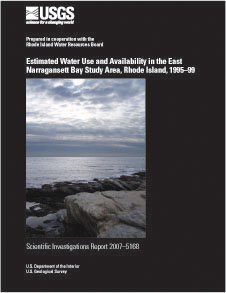Scientific Investigations Report 2007–5168

This report is available as a printed product and in PDF Format (3.91 MB)
The cover for this report is also available in PDF Format (165 KB)
If you have Adobe® Acrobat® or Adobe® Acrobat® Reader® installed on your computer, you may view and print the PDF version of this report. Acrobat Reader, is a free download from Adobe Systems, Inc. Users with disabilities can view information concerning accessibility at access.Adobe.com.
Water availability became a concern in Rhode Island during a drought in 1999, and further investigation was needed to assess the current demands on the hydrologic system from withdrawals during periods of little to no precipitation. The low ground-water levels and streamflows measured in Rhode Island prompted initiation of a series of studies on water use and availability in each major drainage area in Rhode Island for the period 1995–99. The investigation of the East Narragansett Bay area is the last of these studies. The East Narragansett Bay study area (130.9 square miles) includes small sections of the Ten Mile and Westport River Basins in Rhode Island. The area was divided into three regions (islands and contiguous land areas separated by the bay) within each of which the freshwater water use and availability were assessed.
During the study period from 1995 through 1999, three major public water suppliers in the study area withdrew 7.601 million gallons per day (Mgal/d) from ground-water and surface-water reservoirs. The estimated water withdrawals by minor public water suppliers during the study period were 0.063 Mgal/d. Total self-supply domestic, industrial, commercial, and agricultural withdrawals from the study area averaged 1.891 Mgal/d. Total water use in the study area averaged 16.48 Mgal/d, of which about 8.750 Mgal/d was imported from other basins. The average return flow to freshwater within the basin was 2.591 Mgal/d, which included effluent from permitted facilities and septic systems. The average return flow to saltwater (Narragansett Bay) outside of the basin was about 45.21 Mgal/d and included discharges by permitted facilities (wastewater-treatment plants and Rhode Island Pollutant Discharge Elimination Systems).
The PART program, a computerized hydrograph-separation application, was used for the data collected at two selected index stream-gaging stations in the East Narragansett Bay study area to determine water availability on the basis of the 75th, 50th, and 25th percentiles of the total base flow; the base flow for the 7-day, 10-year low-flow scenario; and the base flow for the Aquatic Base Flow scenario for both stations. Base flows in the study area were lowest in September for the 75th, 50th, and 25th percentiles. The safe yields determined for the surface-water reservoirs (14.10 Mgal/d) were added to the estimated available ground water (gross yield) in the Southeastern Narragansett and East Narragansett Islands regions to give the total available water.
The water availability in the study area at the 50th percentile ranged from 33.18 Mgal/d in September to 94.62 Mgal/d in June, water availability for the 7-day, 10-year low-flow scenario at the 50th percentile ranged from 21.87 Mgal/d in September to 83.03 Mgal/d in June, and water availability for the Aquatic Base Flow scenario at the 50th percentile ranged from 14.10 Mgal/d in August and September to 65.48 Mgal/d in June.
Because water withdrawals and use are greater during the summer than at other times of the year, water availability in June, July, August, and September was compared to water withdrawals in the three regions. For the study period, the withdrawals in July were higher than in the other summer months. For the 50th percentile, the ratios of water withdrawn to water available were close to one in August for the estimated basic and Aquatic Base Flow scenarios and in September for the estimated 7-day, 10-year low-flow scenario. For the 25th percentile, the ratios were close to one in August for the estimated basic and for the 7-day, 10-year low-flow scenario, and were close to one in July for the estimated Aquatic Base Flow scenario.
A long-term water budget was calculated for the East Narragansett Bay study area to identify and assess inflows and outflows by region. The water withdrawals and return flows used in the budget were from 1995 through 1999. Total inflow and outflow were calculated separately for each region. Inflow was assumed to equal outflow; the total water budget was 292.1 Mgal/d for the study area. Precipitation and return flow were 99 and less than 1 percent of the total estimated inflow to the study area, respectively. Evapotranspiration, streamflow, and water withdrawals were 47, 49, and 3 percent of the total outflow from the study area, respectively.
Suggested citation:
Wild, E.C., 2007, Estimated water use and availability in the East Narragansett Bay study area: U.S. Geological Survey Scientific Investigations Report 2007–5168, 51 p.
For more information about USGS activities in Rhode Island contact,
Deputy Director
USGS Massachusetts-Rhode Island
Water Science Center, Rhode Island Office
42 Albion Road
Lincoln, RI 02865
http://ri.water.usgs.gov